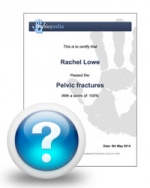Alar Ligament Test
Original Editor - Rachael Lowe
Top Contributors - Rachael Lowe, Admin, Tony Lowe, Evan Thomas, Kim Jackson, Claire Knott, Scott Buxton, George Prudden, Kai A. Sigel and WikiSysop
Purpose[edit | edit source]
To assess the integrity of the alar ligaments and thus upper cervical stability.
Both the side-bending and rotation stress tests for the alar ligaments are based on preventing the inherent coupling of rotation and lateral flexion in the occipito-atlanto-axial complex. That is, lateral flexion of the occiput on the atlas is accompanied by immediate ipsilateral rotation of the axis beneath the atlas. This rotation was proposed by Dvorak and Panjabi[1] to result from tension generated in the alar ligaments.
Technique[edit | edit source]
Both lateral-flexion and rotation stress testing have been validated to result in a measurable increase in length of the contralateral alar ligament[2].
Lateral Flexion[edit | edit source]
First proposed by Aspinall[4] has been described for both sitting[5][6] and supine[7] positions.
In performing this test, the spinous process and lamina of the axis are stabilized by the therapist to prevent both side bending and rotation of the segment. Slight compression is applied through the crown of the head to facilitate atlanto-occipital side bending. Passive side bending then is applied using pressure through the patient's head; in effect, directing the patient's ear toward the opposite side of the neck.
If fixation of the axis is adequate, the normal coupled movement will not be permitted to occur. Hence, no lateral flexion should occur. Testing is recommended to be performed in 3 planes (neutral, flexion, and extension) to account for variation in alar ligament orientation[8]. For a side-bending stress test to be considered positive for an alar ligament lesion, excessive movement in all 3 planes of testing should be evident[9][8]
It has been suggested that testing in both directions is necessary to infer instability due to both alar ligaments tensioning bilaterally during side bending[8] However, Osmotherly et al [10]suggest a clear difference between sides is evident during side-bending testing. This finding indicates that within the ranges in which these ligaments were tested, a bilateral effect on the alar ligaments is not evident and the need for a finding of laxity in both directions is not necessary to infer instability.
In the following video you can see the maneuver in sitting position:
Rotational[edit | edit source]
The rotation stress test[8][7][9] is regarded as primarily stressing the contralateral alar ligament in accordance with the biomechanical description of Dvorak et al. Again, the test is described for both sitting[8][9] and supine[7] positions. The axis is stabilized around its laminae and spinous process using a lumbrical grip. The cranium is grasped with a wide hand span and then rotated, the occiput taking the atlas segment with it, to the end of available range. No lateral flexion is permitted. Some rotation will occur during the test, but the extent of rotation within the bounds of normal is subject to some variation. Estimates of the range of normal rotation vary between 20 and 40 degrees.[8][7][9] As with the side-bending test, the test is repeated in 3 positions in the sagittal plane, with laxity in all 3 positions necessary to establish a positive test finding.[8][7][9][5][6] However, more recently Osmotherly, Rivett and Rowe suggested that the range of craniocervical rotation during rotation stress testing of intact alar ligaments should typically be 21 degrees or less[10] They also suggest that the rotation stress test produces a greater measurable effect on the contralateral alar ligament than the side-bending stress test.
In the following video you can see the maneuver in sitting position and supine:
Evidence[edit | edit source]
A direct effect of these clinical tests on the alar ligaments has been demonstrated, providing support for the construct validity of these screening tests[10].
Read 4 Credit[edit | edit source]
|
Would you like to earn certification to prove your knowledge on this topic? All you need to do is pass the quiz relating to this page in the Physiopedia member area. [Go To Quiz] |
References[edit | edit source]
- ↑ Dvorak J, Panjabi MM. Functional anatomy of the alar ligaments. Spine. 1987;12:183–189.
- ↑ Osmotherly PG, Rivett DA, Rowe LJ. Construct validity of clinical tests for alar ligament integrity: an evaluation using magnetic resonance imaging. Phys Ther. 2012 May;92(5):718-25.[FULL TEXT]
- ↑ Physiotutors. Alar Ligament Stress Test | Upper Cervical Spine Instability. Available from: https://www.youtube.com/watch?v=pj-8cAkFYiA
- ↑ Aspinall W. Clinical testing for the craniovertebral hypermobility syndrome. J Orthop Sports Phys Ther. 1990;12:47–54.
- ↑ 5.0 5.1 Gibbons P, Tehan P. Manipulation of the Spine, Thorax and Pelvis: An Osteopathic Perspective. Edinburgh, Scotland: Churchill Livingstone; 2004
- ↑ 6.0 6.1 Westerhuis P. Cervical instability. In: von Piekartz HJM, ed. Craniofacial Pain: Neuromusculoskeletal Assessment, Treatment and Management. Edinburgh, Scotland: Butterworth Heinemann Elsevier; 2007:119–147
- ↑ 7.0 7.1 7.2 7.3 7.4 Hing W, Reid D. Cervical Spine Management: Pre-screening Requirement for New Zealand. Auckland, New Zealand: New Zealand Manipulative Physiotherapists Association; 2004
- ↑ 8.0 8.1 8.2 8.3 8.4 8.5 8.6 Beeton K. Instability in the upper cervical region: clinical presentation, radiological and clinical testing. Man Ther. 1995;27:19–32.
- ↑ 9.0 9.1 9.2 9.3 9.4 Pettman E. Stress tests of the craniovertebral joints. In: Boyling JD, Palastanga N, eds. Grieve's Modern Manual Therapy: The Vertebral Column
- ↑ 10.0 10.1 10.2 Osmotherly PG, Rivett D, Rowe LJ.. Toward understanding normal craniocervical rotation occurring during the rotation stress test for the alar ligaments. Phys Ther. 2013 Jul;93(7):986-92. doi: 10.2522/ptj.20120266.







